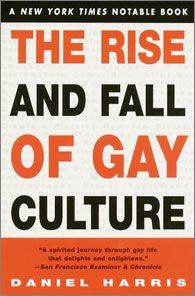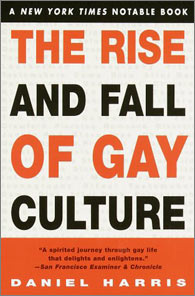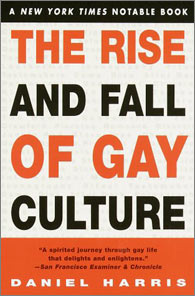The Rise And Fall Of Gay Culture
By: Daniel Harris
Ballantine Publishing Group
Pages: 278

But more and more, new kinds of gay men are making themselves conspicuous. These new gays are drab suburban drones driving SUVs (sport utility vehicles), Republican fundraisers, grungy hip hoppers with low hung jeans, and ordinary guys who like sitting on the sofa drinking beer and watching football on TV. Sound like straight people? Straight-thinking gays are quickly becoming the new homosexual stereotypes in the United States.
The classifieds might call this brave new gay man "straight acting", except that he isn't acting. His preferred pastimes and general attitude are as straight as an arrow. Aside from an idiosyncratic affection for the male member, for all practical purposes there isn't much difference between the new gay man and his straight twin. The line between straight and gay in American culture is vanishing, and gay culture has begun morphing into the heterosexual mainstream.
Gay people around the world should stand up and take notice. The U.S. leads the world in more than just fast food and missile defense systems. For the past forty years, gay Americans have pioneered new lifestyles and political agendas. Where America goes, other Homo sapiens usually follow. So when gay Americans start sex-changing into straight guys, it just might signal the start of an important new worldwide trend.
The straightening out of gay culture is unprecedented. Previous trends in gay American culture have all been unique to the homosexual community. The 1950s Judy Garland fans wept into their gin, 1960s Puerto Rican drag queens threw Molotov cocktails at New York police cars, and 1970s mustachioed clones exchanged bodily fluids at the tubs with carefree abandon.
However different each of these expressions of gay culture was from one another, each was nevertheless exclusive to the gay community. In each case, a unique gay ethnic culture distinguished gay men from the mainstream.

Most of all, they wanted straights to tremble in their wake. Marching to the Hi-NRG pulse of Bronski Beat, queer foot soldiers were going to invade straight suburbia and rape the men, exile the women, and abolish the children. They would burn down mock Tudor homes, uproot the marigold beds, and sow immaculately trimmed lawns with salt. Radical queers saw heterosexuality as an arrogant provocation, and they couldn't wait to duke it out with the straights in a final sexual Armageddon.
How times change. Now the rehabilitated queer revolutionary and his long-term lover are pushing around a stroller containing an adopted Korean orphan girl, taking jalapeno meatloaf to pot luck dinners at the local church, and practicing 1950s style monogamy. In other words, they're turning straight.
The straightening out of the gay world is the subject of The Rise and Fall of Gay Culture by Daniel Harris. This book is an eloquent and passionate diatribe about recent changes in gay male culture in the United States. Although Harris has the capable eye of a skilled academic, he doesn't believe in cold objectivity. Unlike Dr. Kinsey, he isn't an entomologist impassively describing some exotic new creature. To the contrary, he's mad as hell about recent changes in gay culture. Although he considers the turn toward straightness inexorable, he doesn't like it one bit. His emotional engagement pulls the reader into the heart of his fascinating subject matter.
The Rise and Fall of Gay Culture reads so well because Harris backs up his arguments with a fascinating array of evidence culled from unexpected sources. He uses the evolution of porn films, underwear, magazines, personal ads, and musical taste to illustrate each point. Reading this book is like rummaging through a half-forgotten attic packed with dusty artifacts from the last few decades of gay life.

Although there's no natural link between having sex with men and liking ballet, gay men put the two together. By embracing aestheticism, homosexuality rose above two strangers rutting in the YMCA showers to become a distinct and rich ethnic culture filled with beauty, wit, and irony. This unique culture turned gay men into the world's most successful aesthetes. Everyone now knows that many of the greatest artists, writers, fashion designers, musicians, and actors of the past century have been gay.
Straight people acknowledge the aestheticism of gay culture even when they mock it. They may snigger at the stereotypical limp-wristed lisping interior decorator taking his French poodle for a walk. But there's a grain of truth behind this crude image. They're laughing at gay culture by exaggerating its most distinctive feature: aestheticism. Gay people have seized on beauty, elegance, and refinement as a private playground. Aestheticism is the essence of classic gay culture.
Harris thinks that there is a good explanation for why gay men have made beauty their personal turf. Gay culture arose in reaction to horrific and terrifying hatred from the mainstream straight world. The gay world has always been a culture under siege. Gay people were desperate to defuse criticisms from straights by raising themselves above the mainstream that damned them.
Bret Hinsch is an Amercian acdemic who has been living in Taiwan for 10 years. He is also the author of 'Passions of the Cut Sleeve: The Male Homosexual Tradition in China.'
Click the link below to read the second and last installment of this review.











 打印版本
打印版本










读者回应
抢先发表第一个回应吧!
请先登入再使用此功能。